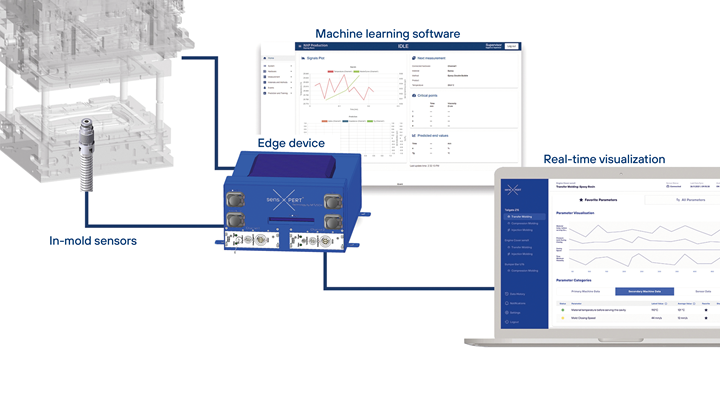In-Mold Solution Drives Dynamic Process Optimization, Data Transparency
The sensXpert platform provides a “customer-centric” approach, enabling moldmakers and plastics processors to measure and monitor temperature and material behavior inside the mold for real-time data and full manufacturing transparency.
Share
SensXpert combines sensor-based mold data with advanced machine learning software to evaluate critical material, machine and process parameters in real time. Photo Credit: Netzsch Process Intelligence GmbH/SensXpert
Netzsch Process Intelligence GmbH’s sensXpert Digital Mold technology is designed calculate and predict important parameters inside the mold. In particular, it combines real-time material data from the mold with advanced machine learning (ML) software to analyze material behavior. The smart technology enables continuous process optimization for up to 30% increase in production efficiency, according to the company, ensuring overall equipment effectiveness. In-mold sensors provide real-time insights and transparency to react to material deviations and eliminate scrap. Allowing a dynamic and adaptive production — and thus maximizing throughput and helping achieve sustainability goals — sensXpert ensures direct in-process quality control of each single molded part.
At the heart of sensXpert’s manufacturing solutions, an Edge Device integrates the hardware and software for ML models designed to capture even the slightest deviation of material and process parameters. Based on measuring data collected from its high-precision sensors, smart machine learning algorithms are applied to simulate, predict and analyze the actual material behavior on each individual machine. The learning models are trained with key parameters, including standard material and experimental data, such as glass transition temperature, pressure and required degree of curing, and are then continuously fine-tuned depending on the in-situ data measured over time.
The process control solution adapts to any common thermoset, thermoplastic and elastomer processing technique, from injection, compression and transfer molding to thermoforming, vacuum infusion and autoclave curing. It connects with customers’ existing manufacturing and control systems through standard industrial interfaces. An intuitive web app is provided for convenient on-site or remote user access.
According to Netzsch, sensXpert is already being used successfully in the automotive and aviation industry, as well as other applications.
Related Content
-
Technology Roundup: New/Improved Technologies You Don't Want to Miss
With all the technology joining the market, moldmaking is a versatile, ever-evolving industry. As such, this technology roundup has no specific theme — it features a variety of products for applications and solutions across the industry.
-
2024 Moldmaking Insights: A Year in Review Part 1
A look back at the top moldmaking trends of 2024, as revealed through MMT's analytics. This review highlights the most popular technical articles, case studies, tips and best practices that captured the industry's attention over the past year.
-
Indiana Mold Builder Decatur Mold Offers a History of Grit and a Future of Innovation
Decatur Mold Tool and Engineering Inc. serves as a tooling tour guide, helping busy tooling managers reduce uncertainty, lighten workload.












